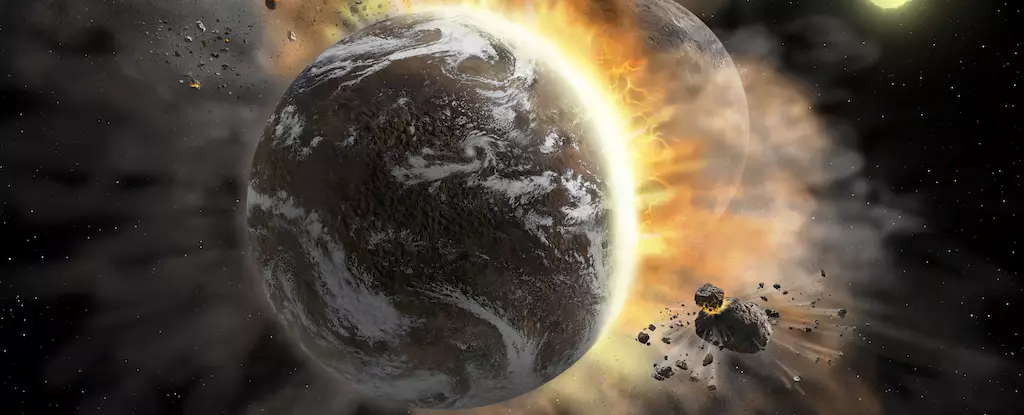When we look up at the Moon, we’re not merely gazing at our nearest neighbor; we are witnessing a historical record of cosmic violence. The Moon’s surface, marred by countless craters, serves as a testament to the tumultuous environment of the early Solar System. In those formative days, our solar neighborhood resembled a chaotic demolition site, where celestial bodies collided with ferocity as they vied for dominance. The implications of this cataclysmic ballet extend beyond our familiar planets, echoing through young star systems across the universe. Recent research dives deep into this dynamic, focusing on how catastrophic events between massive planets can illuminate both our understanding of planetary formation and the inner structures of exoplanets.
The Mechanics of Cosmic Collisions
A recent study takes us into the heart of this chaos by simulating collisions between massive gas giants. Specifically, astronomers targeted a particular exoplanet, Beta Pictoris b, believed to be teeming with heavy metals owing to a history of violent impacts and gravitational interactions. This research blends theoretical physics with the technological prowess of the James Webb Space Telescope (JWST). The aim here is twofold: to assess if a colossal impact can generate seismic waves that resonate within a planet and to evaluate if those waves create observable changes in a planet’s light emissions.
The authors of the research argue that massive exoplanets, such as Beta Pictoris b, which has approximately 13 times the mass of Jupiter, may hold up to 300 Earth masses of heavy metals—a phenomenon attributable to the amalgamation of planetary cores through aggressive collisions. Such dynamics raise profound questions about how celestial bodies accumulate their metallic cores and what this indicates regarding their evolutionary paths.
Seismic Oscillations and Their Cosmic Echoes
Seismic waves, typically associated with earthquakes on Earth, also play a significant role in the interactions of planets. When two massive bodies collide, the impact radiates energy, generating seismic waves that travel through the planet’s interior. This research posits that these oscillations can last for significant periods, remaining detectable long after the initial collision. The findings suggest that if such an impact occurred on Beta Pictoris b within the last 9 to 18 million years, the JWST could capture fleeting changes in the planet’s luminosity as the seismic activity wanes.
The JWST may not be able to directly detect these seismic waves, but it can observe the resultant changes in light—a clever workaround that transforms seismic data into photometric signatures. This presents a fascinating opportunity to probe exoplanet interiors, providing insights into their composition and structure by observing how they respond to seismic activity and the complexities involved in their formation.
Implications for Exoplanet Research
The study not only propels our understanding of seismic activity within planets but also unlocks new avenues for studying the physical characteristics of exoplanets residing light-years away. With traditional methods of measuring a giant planet’s internal structure largely reliant on gravity measurements, the implications of this new approach could revolutionize our comprehension of distant worlds. The insights into both the density and structural stratification of massive planets present opportunities to decipher the nuances of planetary formation, including the enigmatic migrations that might lead to the establishment of ‘hot’ and ‘warm’ Jupiters.
As the researchers pointed out, impacts are just one mechanism to trigger oscillations. The same gravitational forces that orchestrate planetary formation can excite these waves through tidal interactions with their host stars. Such a multifaceted perspective encourages a broader view of how celestial bodies interact within the chaotic fabric of the cosmos, where even the smallest variations can illuminate our understanding of planetary dynamics.
A New Lens on Cosmic Chaos
This groundbreaking research exposes an intricate connection between cosmic collisions and the very characteristics that define planets today. By unveiling how seismic oscillations can serve as indicators of a planet’s health and history, scientists carve out a more vivid picture of our universe. The chaos that defined the early Solar System echoes through time, and now, armed with sophisticated instrumentation like the JWST, we stand on the precipice of a new era in astrophysics. The lessons learned from collisions among exoplanets may, in fact, drive home the point that understanding one planet can provide key insights into others—potentially even unveiling the origins of life on distant worlds.
In a universe as chaotic as ours, every collision tells a story, and every seismic wave becomes a whisper from the depths of the cosmos, urging us to keep listening, exploring, and uncovering the mysteries that lie beyond the stars.


Leave a Reply